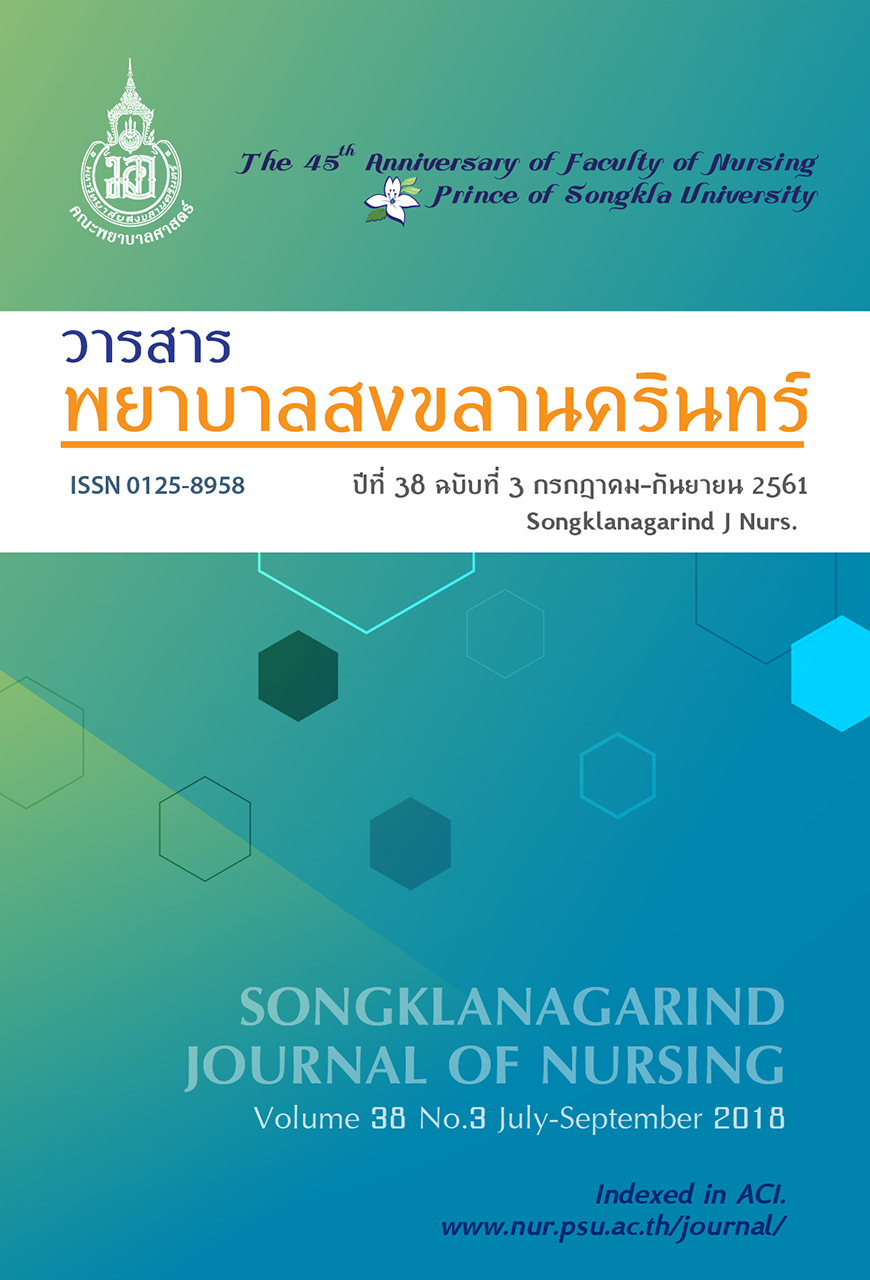Evidence-Based Practice for Pressure Ulcer Prevention Among Perioperative Nurses
Main Article Content
Abstract
This descriptive study aimed to examine level of evidence-based nursing practice to prevent pressure ulcers during surgery of perioperative nurses, as well as to identify the incidence of pressure ulcers in patients undergoing surgery at a tertiary care hospital in the south of Thailand. Data were collected from 110 patients and 41 perioperative nurses. The instruments of the study included observation form and the self-report questionnaire regarding evidence-based nursing practices to prevent pressure ulcers during surgery
of perioperative nurses, and pressure ulcer assessment form. The scale-level content validity index (SCVI) of these instruments was 1. The reliability of the observation form, the self-report questionnaire regarding evidence-based nursing practices to prevent pressure ulcers, and pressure ulcer assessment form was .87, .87 and 1, respectively. Data were analyzed using descriptive statistics.
The results showed that the level of evidence-based nursing practice to prevent pressure ulcers during surgery of perioperative nurses was at a good level. However, the incidence of pressure ulcers immediately after surgery was 3.6%. There was no increase in incidence of pressure ulcers within 24 hours after surgery.
These findings indicated that although nursing practice for preventing pressure ulcers in patients undergoing surgery is at a good level, an incidence of pressure ulcers could be occurred. Therefore, further studies to find out best practices for pressure ulcer prevention among patients undergoing surgery are required.
Article Details
References
2. Gardiner JC, Reed PL, Bonner JD, et al. Incidence of hospital-acquired pressure ulcers–a Population-based cohort study. Int Wound J. 2016; 5(13):09-20.
3. Rungsangchan K, Sai-La W, Prasungsit J. Improving efficency for caring patien: SSIET Bundle. Paper presented at the annual conference 2015:Nursing step into a high perfomance organization on 8-9 December 2015; Bangkok: Faculty of Medicine, Mahidol University, Bangkok.; 2015.
4. Webster J, Lister C, Corry J, et al. Incidence and risk factors for surgically acquired pressure ulcers: A prospective cohort study investigators. J Wound Ostomy Continence Nurs. 2015;42(2):138-44. doi: 10.1097/WON.0000000000000092
5. Furuno Y, Sasajima H, Goto Y, et al. Strategies to prevent positioning-related complications associated with the lateral suboccipital approach. J Neurol Surg B Skull Base. 2014;75(1):35-40. doi: 10.1055/s-0033-1353366
6. Nojit S. Development of clinical practice guidelinesfor pressure ulcer prevention among older persons during open heart operation, Maharaj Nakorn Chiangmai [Thesis]. [Chiangmai]: Chiangmai university;2013.141 p.
7. Bulfone G, Marzolil I, Wuattrin R, et al. A longitudinal study of the incidence of pressure sores and the associated risks and strategies adopted in Italian operating theatres. J Perioper Pract. 2012;22(2):50-6. doi: 10.1177/175045891202200202
8. Tschannen D, Bates O, Talsma A, et al. Patient-specific and surgical characteristics in the development of pressure ulcers. Am J Crit Care. 2012; 21(2): 116-25. doi: 10.4037/ajcc2012716
9. Primiano M, Friend M, McClure C, et al. Pressure ulcer prevalence and risk factors during prolonged surgical procedures. AORN J. 2011; 94(6): 555-66. doi: 10.1016/j.aorn.2011.03.014.
10. Brown CE, Wickline MA, Ecoff L, et al. Nursing practice, knowledge, attitudes and perceived barriers to evidence-based practice at an academic medical center. J Adv Nurs. 2009;65(2):371-81. doi: 10.1111/j.1365-2648.2008.04848.x
11. Panagiotopoulou K, Kerr SM. Pressure area care: An exploration of Greek nurses’ knowledge and practice. J Adv Nurs. 2002; 40(3): 285-96.
12. Sriratanaban J, Potisat S, Angsuroj Y, et al. Hospital quality indicators. 5th ed. Bangkok: Desire CRM; 2000. Thai.
13. Holzemer WL, Reilly CA. Variables, variability, and variations research: Implications for medical informatics. J Am Med Inform Assoc. 1995;2(3):183-90.
14. Shaw LF, Chang PC, Lee JF, et al. Incidence and predicted risk factors of pressure ulcers in surgical patients: Experience at a medical center in Taipei. BioMed Research International. 2014. doi: 10.1155/2014/416896
15. Kelvered M, Ohlen J, Gustafsson BA. Operating theatre nurses’ experience of patient-related, intra-operative nursing care. Scand J Caring Sci. 2012;26(3): 449-57. doi: 10.1111/j.1471-6712.2011.00947.x
16. Wongpimoln B. The association between nurse staffing, nurses’ work environment and nurses’ health related quality of life in general hospitals, northeastern Thailand [Thesis]. [Khon kaen]: Khon kaen university; 2012. 154 p.
17. Haesler E. National pressure ulcer advisory panel, European pressure ulcer advisory panel and pan pacific pressure injury alliance. Prevention and treatment of pressure ulcers: quick reference guide [Internet]. 2014. [cited 2015 Nov 7]. Available from https://www.benchmarquegroup.com.au/wp-content/uploads/2015/12/Prevention Treatment PressureUlcers.pdf
18. Tangsathajaroenporn W. Effects of perioperativepressure ulcer prevention care bundle in neurosurgery patients, maharaj nakorn chiangmai. [Internet]. 2013. [cited 2016 Feb 7]. Available from: http://www.med.cmu.ac.th/ hospital/nis/downloads/?p=3089
19. Shoemake S, Stoesssel K. The clinical issue pressure ulcer in the surgical patient. Kimberly-Clark Heath Care Education [Internet]. 2007 [cited 2016 May 7]. Available from http://pt. halyardhealth.com/media/1513/h0277-0701_ci_pressure_ulcer.pdf.
20. Yamane T. Statistics: An introductory analysis. 2 nd ed. New York: Harper and Row; 1967.
21. O’Brien DD, Shanks AM, Talsma A, et al. Intraoperative risk factors associated withpostoperative pressure ulcers in critically ill patients: a retrospective observational study. Crit Care Med. 2014;42(1):40-7. doi:10.1097/CCM.0b013e318298a849.
22. Scarlatti KC, Michel JL, Gamba MA, et al. Pressure ulcers in surgery patients: incidence and associated factors. Rev Esc Enferm USP. 2011;45(6):1372-79.
23. Wu T, Wang ST, Lin PC, et al. Effects of using a high-density foam pad versus a viscoelastic polymer pad on the incidence of pressure ulcer development during spinal surgery. Biol Res Nurs. 2011;13(4):419-24. doi:10.1177/1099800410392772
24. Black J, Fawcatt D, Scott. S. Ten top tips: Preventing pressure ulcers in thesurgical Patient [Internet]. 2014 [cited 2016 Jan 7]. Available from: http://www. wintjournal.com/media/journals/1138/files/014_wint_5-4_black-et-al.pdf
25. Emily H. National pressure ulcer advisory panel, European pressure ulcer advisory panel and pan pacific pressure injury alliance. Prevention and Treatment of Pressure Ulcers: Quick Reference Guide Cambridge Media. 2014.
26. Yoshimura M, Iizaka S, Kohno M, et al. Risk factors associated with intraoperatively acquired pressure ulcers in the park-bench position: A retrospective study. Int Wound J. 2015;23(6): 1206-13.doi: 10.1111/iwj.12445


